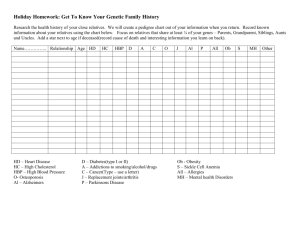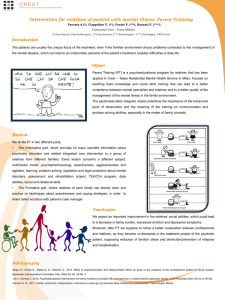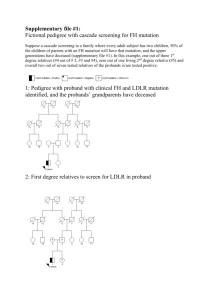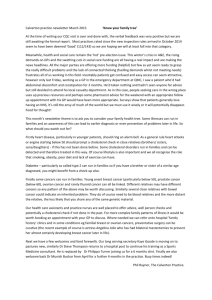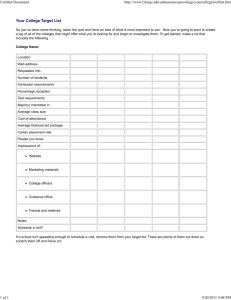Chapter 8: Price and Quantity Indexes
advertisement
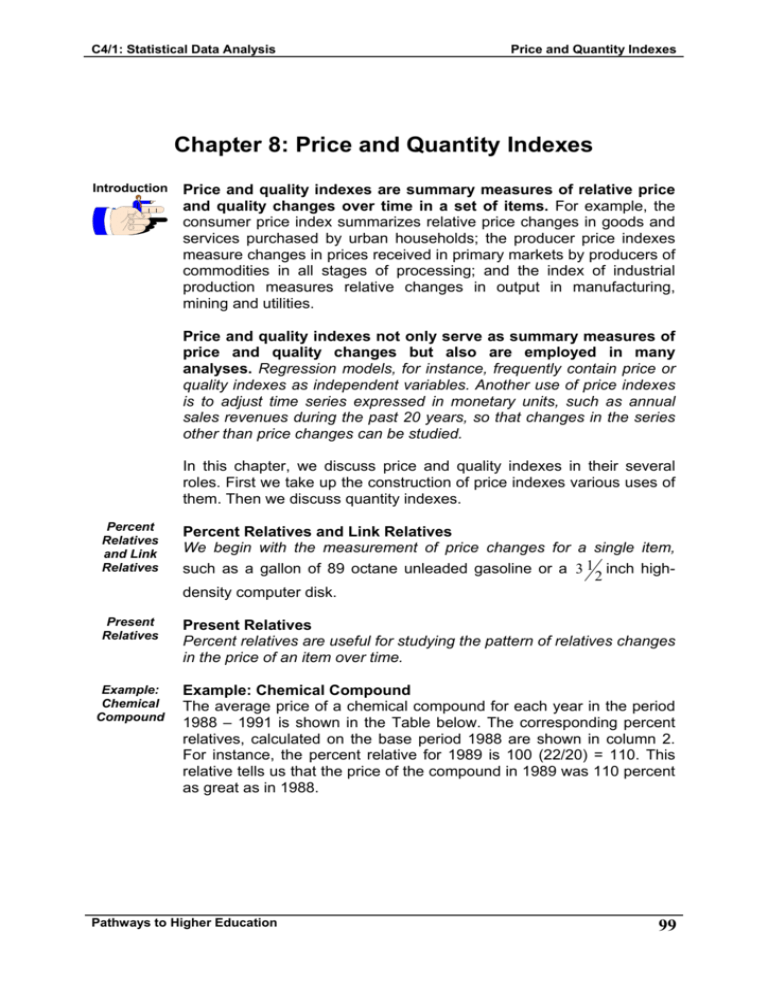
C4/1: Statistical Data Analysis Price and Quantity Indexes Chapter 8: Price and Quantity Indexes Introduction Price and quality indexes are summary measures of relative price and quality changes over time in a set of items. For example, the consumer price index summarizes relative price changes in goods and services purchased by urban households; the producer price indexes measure changes in prices received in primary markets by producers of commodities in all stages of processing; and the index of industrial production measures relative changes in output in manufacturing, mining and utilities. Price and quality indexes not only serve as summary measures of price and quality changes but also are employed in many analyses. Regression models, for instance, frequently contain price or quality indexes as independent variables. Another use of price indexes is to adjust time series expressed in monetary units, such as annual sales revenues during the past 20 years, so that changes in the series other than price changes can be studied. In this chapter, we discuss price and quality indexes in their several roles. First we take up the construction of price indexes various uses of them. Then we discuss quantity indexes. Percent Relatives and Link Relatives Percent Relatives and Link Relatives We begin with the measurement of price changes for a single item, such as a gallon of 89 octane unleaded gasoline or a 3 1 inch high2 density computer disk. Present Relatives Present Relatives Percent relatives are useful for studying the pattern of relatives changes in the price of an item over time. Example: Chemical Compound Example: Chemical Compound The average price of a chemical compound for each year in the period 1988 – 1991 is shown in the Table below. The corresponding percent relatives, calculated on the base period 1988 are shown in column 2. For instance, the percent relative for 1989 is 100 (22/20) = 110. This relative tells us that the price of the compound in 1989 was 110 percent as great as in 1988. Pathways to Higher Education 99 C4/1: Statistical Data Analysis Price and Quantity Indexes Calculation of percent relative and link relatives series – chemical compound example Year 1988 1989 1990 1991 (1) Average Price (dollars) 20 22 36 50 (2) (3) Percent Relatives 1988=100 1991=100 100 110 180 250 40 44 72 100 (4) Link Relative 110 164 139 The base period for a percent relatives series is usually identified for reporting purposes in the manner shown in the above Table; for example, 1988 = 100. The base period may be any period that facilitates the comparisons of interest. For instance, the choice of 1988 in the chemical compound Example facilitates the study of the price increases during a period when demand was increasing rapidly because of a new industrial use for the compound. Interpretation of Percent Relatives Interpretation of Percent Relatives Percent relatives must be interpreted with care. We discuss briefly three important considerations. 1. The absolute magnitudes of percent relatives are affected by the choice of the base period, but their proportional magnitudes are not affected by this choice. We illustrate this for the chemical compound Example by presenting in column 3 of the above Table the percent relatives calculated on the base period 1991. The percent relative for 1988 now is 100(20/50 = 40, not 100 as for the 1988 base period series. However, the proportional magnitudes of the percent relatives in columns 2 and 3 are the same. For instance, the percent relatives for 1989 and 1988, with base period 1988, have the ratio 110/100 = 1.1. For the percent relatives with the 1991 base period, this ratio is the same; that is, 44/40 = 1.1. Similarly for both series of percent relatives, the ratio of the 1990 price relative to the 1989 price relative is 1.64. 2. A comparison of percent relatives for two different price series indicates nothing about the actual prices unless we know the actual magnitudes in the base period. For example, information that the percent relatives for large "grade-A" eggs last month were 120 for Montreal and 123 for Toronto tells us nothing about how the egg prices in the two cities compared last month unless we know the prices in the base period. 3. In analyzing percent relatives, we distinguish between percent points of change and percent change. To illustrate the difference, refer to the percent relatives with base period 1988 in column 2 of the Table for the chemical compound example. Between 1990 and 1991, the Pathways to Higher Education 100 C4/1: Statistical Data Analysis Price and Quantity Indexes percent points of change were 250 - 180 = 70. On the other hand, the percent change was 100[(250-180)/180] = 100(70/180) = 38.9. Thus, a percent point of change refers to the absolute change in the percent relatives and is dependent on the choice of the base period. Percent change, in contrast, refers to the relative change in percent relative and, as we noted previously, is not affected by the choice of the base period. Link Relatives Link Relatives Link relatives are useful in studying relative period-to-period changes instead of change from a fixed base period. For instance, link relatives enable us to study whether or not the price of an item is increasing at a constant rate, an increasing rate, or a decreasing rate. A link relative series express the value of the series in each period as percent of the value in the immediately preceding period. Example Example The link relatives for the chemical compound Example are given in column 4 in the same Table of the above Example. For instance, the link relative for 1989 is 100(22/20) = 110. This tells us that the price in 1989 was 110 percent as great as in 1988. The link relative for 1990 is 100(36/22) = 164, indicating that the price in 1990 was 164 percent as great as in 1989. Note that the percent increase from 1990 to 1991 was smaller than that from 1989 to 1990 (column 4), even though the amount of price increase ($14) did not decline (column 1). Comment Price Index by Method of Weighted Aggregates Comment We have illustrated percent relatives and link relatives for price series, but these relatives can be utilized for any time series (for example, annual sales or monthly production). 8.1 Price Index by Method of Weighted Aggregates Price indexes are summary measures that combine the price changes for a group of items, using weights to give each item its appropriate importance. The consumer price index is such an index measuring the combined effect of price changes in many goods and services purchased by urban households. Two basic methods are widely used for calculating price indexes: the method of weighted aggregates and the method of weighted average of relatives. We shall explain each in turn, using the following illustration. Example: School Maintenanc e Supplies Example: School Maintenance Supplies Officials of a large school district needed to develop a price index for maintenance supplies for the school buildings in the district. In compiling this index, the officials could not include all supply items in Pathways to Higher Education 101 C4/1: Statistical Data Analysis Price and Quantity Indexes the index because the number of supply items used is very large. Instead, a sample of supply items was selected to represent all items used. The selected items are shown in Tabulated below, column 1. Also shown in this table, in columns 3, 4, and 5, are the unit prices of these items for 1988, 1989 and 1990, respectively. Finally, column 2 of the Table presents typical quantities consumed annually for each of the selected supply items. Method of Weighted Aggregates Method of Weighted Aggregates The method of weighted aggregates for compiling a price index simply compares the cost of the typical quantities consumed at the prices of a given period with the corresponding cost in the base period. We shall first explain the notation and terminology used we illustrate the method of calculation by an example. Calculation of price index series by method of weighted aggregates-school maintenances supplies example (1) Schedule of Items (2) Quan tity Q ia 1 Window glass 2 Fluorescent tube 3 Floor detergent 4 Floor finish 5 Latex interior paint 6 Mop head 15 sheets 130 boxes 290 cans 100 cans 175 cans 200 pieces (3) (4) (5) (6) (7) (8) Unit Price P10Q12 P11Q12 P 12Q 1a 1998 1989 1990 5x2 P10 P11 P12 (3) x (2) (4)x (2) 15.55 15.86 16.21 233.25 237.90 39.17 39.81 40.55 5.092.1 5.175.3 5.271.5 21.95 23.55 24.90 6.365.5 6.829.5 7.221.0 49.39 52.27 25.53 4.939.0 5.227.0 5.253.0 11.13 11.50 11.56 1.94.75 2.012.5 2.023.0 2.86 572.00 586.00 19.149.6 20.068.2 20.609.6 5 2.93 Total 2.99 243.15 598.00 ⎛ 19.149.60 ⎞ I 88 = ⎜ ⎟ = 100.0 ⎝ 19.149.60 ⎠ ⎛ 20.068.20 ⎞ I 89 = ⎜ ⎟ = 100.0 ⎝ 19.149.60 ⎠ ⎛ 20.609.65 ⎞ I 90 = ⎜ ⎟ = 100.0 ⎝ 19.149.60 ⎠ The schedule of items is the list of items included in the price index. Often, the schedule of items consists of a sample of all items of interest, as in the school maintenance supplies example. Sometimes, it is Pathways to Higher Education 102 C4/1: Statistical Data Analysis Price and Quantity Indexes The price of the Ith item in the schedule in any given period t is denoted by Pit and the price of this item in the base period is denoted by Pio. The typical quantity consume the ith item is denoted by Qia where the subscript a stands for an average or typical period. These quantities are used as weights to reflect the importance of each item. The method of weighted aggregates compares the cost of the typical quantities period t prices with the cost of the same quantities at base period prices. The cost at period t prices is: Cost at period t prices = ∑ P it A ia i Where the summation is over all the items in the schedule. The cost at base period price is : Cost at period 0 prices = ∑ P io A ia i The price index for period t by the method of weighted aggregates is the ratio of these two costs, expressed as a percent. The price index for period t will be denoted by 1it. I it = 100 ∑ ∑ P it Q ia P ia Q ia Where: Pio is the unit price of the ith item in period o (based period). Pit is the unit price of the ith item in period t (given period). Q ia is the quantity weight assigned to the ith item Example Example For the schools maintenance supplies example, the price index series for 1988, 1989, and 1990 is calculated by the method of weighted aggregates. Columns 6. 7 and 8 contain the costs of the typical quantities at the prices of each year. For example, the cost of 15 sheets of window glass at 1988 prices is 15(15.55) = 233.25 while at 1989 prices the cost is 15(15.86) = 237.90. The aggregate costs of the schedule of items at the prices of the three periods are shown at the bottoms of columns 6, 7, and 8, respectively. The index numbers are calculated at the bottom of the table. Since the same items and quantities are priced in each period, the differences in the index are attributable wholly to changes in the prices of the items. Thus, the price index I89 = 104.8 indicates that the prices of school maintenance supplies increased, in terms of their aggregate effect, by 4.8 percent between 1988 and 1989. Since the index for 1990 (I90 = 107.6) is above the index for 1989 (I89 = 104.8), the prices, in their aggregate effect, increased still more between 1989 and 1990. We calculate the percent price increase between 1989 and 1990 by expressing the percent point change, 107.6 - 104.8 = 2.8, as a percent of the 1989 index and obtain 100 (2.8/104.8) = 2.7 percent as the relative price increase between 1989 and 1990. Pathways to Higher Education 103 C4/1: Statistical Data Analysis Comments Price Index by Method of Weighted Average of Relatives Price and Quantity Indexes Comments 1. Just as with percent relatives, the proportional magnitudes of the index numbers in the Table are not affected by which period is chosen as the base period. 2. The period from which the quantity weights are derived is called the weight period. The base period for the price index and the weight period need not coincide. 3. When the typical quantity weights Qit are the quantities consumed in the base period - that is, Qot the weighted aggregates price index is called a Laspeyres price index. 8.2 Price Index by Method of Weighted Average of Relatives A second method of compiling a price index series is the method of weighted average of relatives. This method utilizes the percent relatives of the prices for the item in the schedule. The index for period t is simply a weighted average of the percent relatives for all schedule items. The weights required by this method are value weights rather than quantity weights. We shall denote the value weight for the Ith item by Via. The price index it for period t calculated by the method of weighted average of relatives is ⎛ P it ⎞ ⎟ V ia ⎜⎜ 100 P ia ⎟⎠ ⎝ IT = ∑ i ∑ V ia Where: Pio is the unit price of the ith item in period o (based period). Pit is the unit price of the ith item in period t (given period). Via is the value weight assigned to ith item. The value weights Via are dollar values that reflect the importance of each item in the schedule. For example, the value weights may be obtained from the typical quantities consumed, Qia by multiplying these quantities by typical prices. Example Example For the school maintenance supplies example, we shall calculate a price index series by the method of weighted average of relatives with base period 1988. The value weights will be based on the typical quantities and the unit prices for the base period 1988 in the Table that is: Via = Pio Qia Pathways to Higher Education 104 C4/1: Statistical Data Analysis Price and Quantity Indexes The necessary calculations are tabulated below. Column 1 in the Table repeats the schedule of Items, and column 2 contains the value weights as obtained from the Table. For example, the value weight for window glass is Via = Pio Qia = 15.55(15) = 233.25. The sum of the value weight is ∑V = 19 . 149 . 60 ia Columns 3, 4, and 5 contain the percent relatives for the prices of each schedule Item in the three years based on the data in the Table. Note that all percent relatives are expressed on a 1988 base because the price index is to have 1988 as the base period. For example, the 1989 percent relative for window glass is 100(15.86/15.55) = 101.99. We now take a weighed average of the percent relatives for each year. The weighting is done in columns 6, 7, and 8, and the indexes are obtained at the bottom of the table. The index I89 = 104.8 for 1989 indicates that prices of school maintenance supplies increased, in terms of their aggregate effect, by 4.8 percent between 1988 and 1989. Comment Comment The price indexes in Tables 26.2 and 26.3 are identical. This happened because we used base year prices P10, in obtaining the value weights. In that case, the method of weighted average of relatives index (26.4) reduces to the method of weighted aggregates index (26.3) as follows: ∑ i ⎛ P ⎜⎜ 100 it P io ⎝ ∑ V ia i ⎞ ⎟⎟ V ia ⎠ = ⎛ ∑ ⎜⎜ 100 i ⎝ ∑ i ⎞ ⎟⎟ P io V ia ⎠ = 100 P io Q ia P it P io ∑P ∑P it V ia io Q ia i i When prices other than base period prices are used for obtaining the value weights Via, the two methods will not lead to identical results. Generally, though, the differences in the indexes calculated by the two methods will not be great. We now take up several considerations that arise in compiling index numbers series. Considerati ons in Compiling Index Series 8.3 Considerations in Compiling Index Series Choice of Base Period: We now take up several considerations that arise in compiling index numbers series. Any period within the coverage of the index series can be used as the base period. Of course, when a special-purpose index is designed to measure price changes occurring since particular period, such as since the lifting of price controls, that period would be taken as the base period. Whenever possible, the base period should involve relatively normally standard conditions, because many index users assume that the base period represent, such conditions. Sometimes an interval of two or more years is selected as the base period. In this case, the index numbers are calculated so that Pathways to Higher Education 105 C4/1: Statistical Data Analysis Price and Quantity Indexes the indexes for the base period year average to 100. The base period is then reported in a form such as 1990-1991 = 100. Calculation of price index series by method of weighted average of relatives-school maintenance supplies example (1) Schedule of Items (2) Value Weight Via=PioQia Window glass Fluoresc ent tube Floor detergent Floor finish Latex interior paint Mop head (3) 1998 ⎛P 100 ⎜⎜ it ⎝ P io ⎞ ⎟⎟ ⎠ (4) Unit Price (5) 1989 1990 ⎛P 100 ⎜⎜ ii1 ⎝ Pio ⎞ ⎟ ⎟ ⎠ (6) (7) (8) Percent Relative x Value Weight 1998 1989 1990 ⎛ P ⎞ 100 ⎛⎜ Pit ⎞⎟V 100 ⎛⎜ Pit ⎞⎟V ⎜ P ⎟ ia ⎜ P ⎟ ia 100 ⎜ it ⎟ ⎝ io ⎠ ⎝ io ⎠ ⎜P ⎟ ⎝ io ⎠ (5)x(2) 233.25 100.0 101.99 104.24 (3)x(2) 23.325 5.092.10 100.0 101.63 103.52 509.210 517.510 527.134 60365.5 100.0 107.29 113.44 636.550 682.954 722.102 4.939.00 100.0 105.83 106.36 493.900 522.694 525.312 1.947.75 100.0 103.32 103.86 194.775 201.242 202.293 572.00 100.0 102.45 104.55 57.200 58.601 19.149.6 Total (4)x(2) 23.789 ⎛P ⎞ 100 ⎜⎜ it ⎟⎟Via ⎝ Pio ⎠ 24.314 59.803 1914.96 2.006.79 2.060.958 ⎛ 1 . 914 . 960 I 88 = ⎜ ⎝ 19 . 149 . 60 ⎛ 2 . 006 . 790 I 89 = ⎜ ⎝ 19 . 149 . 60 I 90 Shifting of Base Period ⎞ ⎟ = 100 . 0 ⎠ ⎞ ⎟ = 104 . 8 ⎠ ⎛ 2 . 060 . 9585 ⎞ =⎜ ⎟ = 107 . 6 ⎝ 19 . 149 . 60 ⎠ Shifting of Base Period Sometimes it is necessary to shift the base period of an index series that is already compiled, as when two index series on different base periods need to be placed on a common base period to facilitate comparison. Usually it is not possible to recalculate a published index on the new base period because the needed data are not available. A shortcut method can be employed; however, that does not entail recalculation of the index. To illustrate the shortcut procedure, let us consider the following price index series with 1989 as the base period: Year Price Index (1989 = 100): Pathways to Higher Education 1986 75 1987 88 1988 1989 1990 1991 92 100 110 122 106 C4/1: Statistical Data Analysis Price and Quantity Indexes Suppose the base period is to be shifted to 1986. We simply divide each index number by 0.75, the index number for the new base period in decimal form. The index number for 1986 becomes 75/0.75 = 100.0, that for 1987 becomes 88/0.75 = 117.3, and so on. The new price index series with base period 1986 is: Year 1986 Price Index 100.0 (1986 = 100): 1987 117.3 1988 122.7 1989 133.3 1990 146.7 1991 162.7 Because the proportional magnitudes of the index numbers are not affected by this shifting, the new series conveys the same information about year-to-year relative price changes as the original series. The shortcut procedure yields results identical to those obtained by recalculating the index series on the new base period when the index series is calculated by the method of weighted aggregates with fixed quantity weights. With most other formulas, however, the shortcut procedure only provides approximate results. Splicing Splicing When an index series is revised, the new series can be joined or spliced to the older series to yield a single continuous series by a procedure similar to that just described for shifting the base period of an index series. Suppose the following two price index series are to be joined: Year 1983 1984 1985 1986 1987 1988 1989 1990 1991 Old Series 100 103 106 113 130 (1983 = 100) Revised Series 100 120 126 131 134 (1987 = 100) To splice the two series together, we simply shift the level of one of the series so that both have a common value for 1987. For instance, to obtain a combined series with 1983 as the base period, we multiply every index in the revised series by 1.30. The spliced series is: Year 1983 1984 1985 1986 1987 1988 1989 1990 1991 Spliced Series 100 103 106 113 130 156 164 170 174 (1983 = 100): Collection of Price and Quantity Data Collection of Price and Quantity Data All of the data-collection methods discussed is used in collecting data for price indexes. Price and quantity data are obtained by Pathways to Higher Education 107 C4/1: Statistical Data Analysis Price and Quantity Indexes observation, interview, and self- enumeration. Often sampling is used, as in the consumer price index where probability samples of retail outlets and of items carried by the selected outlets are employed to obtain price data. Sampling is also used for the consumer price index in periodic consumer expenditures surveys to obtain quantity data for weights. In collecting price data for an item over a period of years, it is important that the quality and other price-determining characteristics be held as constant as possible. This typically requires that detailed specifications be developed and adhered to in pricing the item. Here if is an Example of such a specification: Interior latex paint. Professional - or commercial - grade latex interior house paint, matte or flat finish off white, first - line or quality. Note that color, finish, and quality are specified because each of these characteristics can affect the price. A different problem in collecting price data in ongoing index series is the adjustment for quality changes in the items covered by the index. In principle, a price change that is caused by a quality change should not be reflected in the price index. In practice, minor quality changes are ignored. On the other hand, attempts are made in better price indexes to adjust for important quality changes. However, the conceptual and measurement problems are difficult. For instance, if an oven door is modified by the manufacturer to exclude the glass window while the list price remains unchanged, should this be treated as a price increase and reflected in the index? If so, what should be the magnitude of the imputed increase? Extensive research has been undertaken on how problems connected with quality changes should be handled. Another issue in compiling an index series concerns weights. In some indexes, the schedule includes all or almost all of the items used in the activity. For instance, in a price index for highway construction, where a relatively small number of major items account for most of the total cost, it suffices for practical purposes to limit the schedule to these major items. Here, each weight reflects the importance of the particular item. Often, however, the schedule must be limited to a sample of items, since thousands of items may be involved in the activity and it is neither feasible nor necessary to include them all. Each item is then selected for the schedule to represent a class of related items. In such cases, the weight for an item normally reflects the importance of the entire class represented by the item. Consider, for instance, a particular type of insulation that was selected for a price index for residential building construction to represent all types of insulation and vapor barriers. The weight for the insulation the schedule Pathways to Higher Education 108 C4/1: Statistical Data Analysis Price and Quantity Indexes here needs to represent the importance of the entire class of insulation and vapor barriers. Maintenanc e of Price Index Series Maintenance of Price Index Series A key issue in the maintenance of price index series involves changes in the items included in the index and in the weights assigned to the items to keep them up to date. Should the schedule of items and the weights be changed frequently so that they are always up to date or should they be held fixed over a relatively long sequence of years? If frequent changes are made, changes in the price index series over time will reflect both changes in price, and changes in the composition of the index. Another disadvantage of frequent revision is that it may be very expensive. On the other hand an index can become badly outdated if the schedule of items and the weights are held fixed over too long a period. The procedure generally followed in practice is to hold the schedule of items and the weights essentially fixed for 5 to 10 years and then to revise them. The schedule and weights need not be held exactly fixed, since procedures are available for making inter adjustments without disturbing the index. For instance, a new item can be substituted for an item that has been taken off the market. And seasonal items, such as fresh produce, can be included in the schedule in season. In addition to periodic updating of the schedule of items and the weights, revisions often also include upgrading of data collection and data handling procedures and modernizing of definitions. A new series of index numbers is then initiated with each revision. The new series can be joined to the preceding series, if desired, by the splicing procedure already explained. Uses of Price Indexes Measuring Real Earnings Example: Weekly Earnings 8.4 Uses of Price Indexes Price indexes play important roles in a variety of applications. We now consider two important uses of price indexes. Measuring Real Earnings As prices change, so does the quantity of goods and services that can be purchased by a fixed sum of money. In economic analysis, it is frequently important to measure change in real earnings (that is, in the quantity of goods and services that can be purchased). Price indexes are a basic tool in making this measurement. Example: Weekly Earnings Average weekly dollar earnings of production or non-supervisory workers on non-agricultural payrolls in the United States during the period 1985-1989 are shown in the Table below. These earnings data are expressed in current dollars. For example, 1985 earnings are expressed in terms of the buying power of workers' dollars in 1985, and Pathways to Higher Education 109 C4/1: Statistical Data Analysis Price and Quantity Indexes earnings in 1986 are expressed in terms of the buying power of workers' dollars in 1986. We see that earnings in current dollars increased steadily during the period. The extent to which the prices of goods and services purchased for daily living by the workers and their dependents changed during the period is shown in column 2 by the consumer price index for urban wage earners and clerical workers. This index is expressed on a 1985 base period in the table. Note that prices in 1986 stood at 101.6 percent of their 1985 level. Thus, on the average, families had to spend $1.016 in 1986 for every $1 spent in 1985 in purchasing goods and services for daily living. Consequently, the average weekly earnings of $304.85 in 1986 were equivalent in purchasing power to 304.85/1.016 = $300.05 at 1985 prices. Since 1985 average weekly earnings were $299.09, we see that most of the increase in average weekly earnings between 1985 and 1986 (from $299.09 to $304.85) was offset by price increases and that real earnings increased only slightly. Earnings in current and 1985 dollars - weekly earnings Example (3) (4) (5) Relatives for Column Weekly 3 Earnings in 1985 Dollars Link Percent ( 2) Relative Relative (1 ) ÷ (1985=100) 100 1985 299.09 100.0 299.09 100.0 1986 304.85 101.6 300.05 100.3 100.3 1987 312.50 105.2 297.05 99.0 99.3 1988 322.36 109.4 394.66 99.2 98.5 1989 335.20 114.7 292.24 99.2 97.7 Sourrc: Basic data from Monthly Labor Review Year (1) Weekly Earnings (2) Consumer Price Index (1985=100) The average weekly earnings in the other years at 1985 prices are obtained by the same procedure: Each current earnings figure is divided by the decimal value of the price index for that year. Column 3 of the Table contains the average weekly earnings data expressed at 1985 prices. These data are said to be in constant dollars or 1985 dollars since they are expressed in terms of the purchasing power of the dollar in 1985. Relative changes in constant-dollars earnings indicate the relative changes in purchasing power associated with the money earnings - that is, the relative changes in real earnings. To show these relative changes explicitly, we have expressed the constant dollars data as link relatives in column 4 in the Table and as percent relatives in column 5 with 1985 = 100. The link relatives show that real earnings increased slightly between 1985 and 1986 and then declined a little each year between 1986 and 1989. The percent relatives show that real earnings in 1989 were only at 97.7 percent of their 1985 level. Comment Pathways to Higher Education 110 C4/1: Statistical Data Analysis Comment Measuring Quantity Changes Price and Quantity Indexes We noted earlier that proportional magnitudes in an index series are not affected by the choice of the base period but that the absolute magnitudes are affected. The same holds for constant – dollars series. Thus, in the weekly earnings example, if the consumer price index had been expressed on a 1989 base, the constant-dollars earnings would have differed from column 3 of its Table, but the percent relatives and the link relatives based on these 1989 constant-dollars data would have remained exactly the same. Measuring Quantity Changes Many important business and economic series on volume of activity are expressed in current dollars. Changes in the dollar volume reflect quantity changes, or price changes; or both. Often, there is interest in the quantity changes alone. For example, if retail sales this year are 5 percent higher than last year's sales, is this due to price increases only or did the physical volume of goods sold increase? We can measure relative changes in quantities by the use of price indexes. The procedure is similar to that for expressing current-dollars earnings as constant-dollars earnings. Appliance Sales Example Annual sales (in $ thousands) by a manufacturer of household appliances during 1989-1992 are shown in the Table below. A relevant price index for the products of the manufacturer is shown in column 2. The constant-dollars sales in 1989 dollars are shown in column 3. The calculations parallel those for obtaining constant dollars earnings in the previous Table. The link relatives and the percent relatives (1989 = 100) of the constant-dollars sales are shown in columns 4 and 5, respectively. We see that the quantity of household appliances sold increased by 33 percent between 1989 and 199 and that the annual rate of increase was about 10 percent per year. Manufacturer's sales in current and 1989 dollars appliance sales Example Appliance Sales Example Year (1) Annual Sales ($ thousand) (2) Product Price Index (1989=100) (3) Sales in 1989 Dollars($ thousand) (1 ) ÷ (2 ) 100 1989 1990 1991 1992 Comments 38.500 43.538 49.050 54.950 100 103 105 107 38.500 42.270 46.714 51.355 (4) (5) Relatives for Column 3 Link Percent Relative Relative (1989=100) 109.8 110.5 109.9 100.0 109.8 121.3 133.4 Comments 1. When current-dollars series are converted into constant dollars, the price index must be relevant to the series. For instance, we would not use a food price index to adjust a series appliances Pathways to Higher Education 111 C4/1: Statistical Data Analysis Price and Quantity Indexes sale. or the consumer price index to adjust the sales of a steel manufacturer 2. When a current-dollars series is converted into a constant dollars series, the latter is often refined to as a deflaled series. 8.5 Quantity Indexes Quantity Indexes A quantity index is a summary measure of relative changes over time in the quantities set of items - for instance, in the quantities of automobiles, trucks, and other imported annually by the United States. In such index series, the quantities can from one period to another but the prices or other weights remain fixed. The index mulas are analogous to those for price indexes. The quantity index It, for period t calculated by the method of weighted aggregates is I t = 100 ∑Q ∑Q it P ia io P ia The quantity index for period t calculated by method of weighted average of relatives is It = ∑ ⎛ Q it ⎜⎜ 100 Q io ⎝ V ∑ ia ⎞ ⎟⎟ V ia ⎠ A problem in constructing quantity indexes arises in the choice of weights. The usual price or value weights may not be appropriate here. Consider a company that wishes to measure quantity changes in it outputs of different electronic circuits assembled purchased components. Here, price weights or value weights for the different circuits would reflect mainly the prices or values of the purchased components and not the quantities of assembly work performed by the company per se. Weights derived from the typical number of hours expended in assembling each circuit or form the value added to each circuit in the assembly would be more appropriate. Value added here would be the value of the circuit when shipped from the plant less than the cost of the purchased components and other purchased goods and services (for example, fuel, electricity, containers) used in assembling the circuit and packing it for shipment. The index of industrial production utilizes value-added weights in many of its segments. Pathways to Higher Education 112

